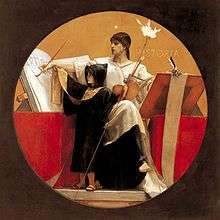Contemporary Greek art
| Part of a series on the |
| History of Greek art |
|---|
 |
| Greek Bronze Age |
| Ancient Greece |
| Medieval Greece |
| Post-Byzantine Greece |
| Modern Greece |
Contemporary Greek Art is defined as the art produced by Greek artists after World War II.
Painting-Sculpture
Abstract Expressionism
Theodoros Stamos (1922-1997) was a great abstract expressionism art from Lefkas that lived and worked in New York in the 40s and 50s. His work has been exhibited throughout the world, and can be found in major museum collections such as the Whitney Museum of Art, the Guggenheim Museum, Smithsonian and the National Gallery of Art in Washington, D.C.[1]
Dimitris Koukos (1948-) is also considered as a great expressionist painter, mainly renowned for his abstract work and landscapes. Dimitris koukos has also had over 30 one man exhibitions and participated in several group exhibitions in Athens, Paris, Boston, Moscow. The artist's works can be found in private collections in the U.S, France, Italy, U.K. as well as at the National Gallery in Athens, the Pieridis Museum, the Vorres Museum, the Cultural Institute of the National Bank of Greece, the Greek Ministry of Culture and the Ministry of Education in Cyprus.
Kinetic Art
Takis was born in 1925 in Athens, and he is an internationally acclaimed self-taught sculptor. He travelled, worked exhibited in Athens, Paris, London, New York and in many other cities. He is particularly known for his telemagnetic sculpture that formed the basis of his aesthetic expression and his musical sculptures. Takis' musical sculptures are based on the simple concept of using magnetic waves caused by electricity as a means to activate repeated musical sounds: the latter are to be heard every time a needle strikes a string, when attracted by a magnet. He won the Grand Prize at the Paris New Biennale in 1985. An illustrative example would be the installation of a real forest of numerous Signs in the Place de la Defence in Paris (1984–87), the original and imaginative illumination of the Arc de Triomphe at the same period, the transformation of the aqueduct at Beauvais into a musical tower with a network of vertical metallic strings, in 1992, and his design for the layout of a subway station in Toulouse in 1993. Takis' non-morphological inquiries have continued through successive rejections of represantationalism; his method and the acoustic sensations which it calls forth retain their austerity. These are the features which place his artistic inventions among the most important achievements of contemporary, post-World War II art.[2]
Arte povera
In Arte povera, artists use any medium they could get for free or very, very cheap. The main Greek representative of arte povera is Jannis Kounellis, who introduced found objects in his paintings, such as live animals but also fire, earth, burlap sacks, gold. He replaced the canvas with bed frames, doorways, windows or simply the gallery itself.[3]
Stuckism
Stuckism is an international artistic movement that was created as a reaction to conceptual art. Stuckist painter Odysseus Yakoumakis on September 2004,founded the first Greek group of Stuckism International named The Romantic Anonymous Fellowship to oppose to the provinciality of the mainstream contemporary Greek art and in particular post-modernism.[4]
Digital Art
Miltos Manetas is an artist who makes paintings, videoworks, prints and performances about video games, players and computer hardware.[5][6]
Andreas Angelidakis is an architect and artist working at the intersection of digital culture and architectural production. He is one of the first artists that treated internet as a real place, a site where he designed and built online communities such as the Chelsea Project, Neen World. He also designed and built spaces, intended to appear as computer renderings, sparking a discussion as to whether they were ever built (Pause pavilion, Stockholm 2002) and spaces that included a garden of mummified plants used as a virtual horizon for a laser beauty clinic (Forever Laser, Geneva 1998 and 2003).[7] Angelidakis has realized projects in Sweden, Switzerland, United States and Italy for publications, museums and cultural foundations.[8]
Lydia Venieri [9] although known as painter and mixed media sculptor started doing internet art in 1994[10] with her showing of Fin at the FIAC95. This was followed by Her Story, Apology (addressed to the artist Takis). Her last digital work Moonlight was released in 2008 for the iPhone.
See also
External links
- Deste foundation official site
- National Museum of Contemporary Art official site
- State Museum of Contemporary Art, Thessaloniki official site
- Contemporary Greek artists Art Topos
- Andreas Angelidakis
- Angelo Plessas
- AngeloSays Blog
- Venieri's Internet Art
Sources
- ↑ Theodoros Stamos
- ↑ takis
- ↑ Jannis Kounellis: the metamorphoses of Apollo
- ↑ 50 cent bingo book cd at odysseus-art.net
- ↑ Miltos Manetas artist and art...the-artists.org
- ↑ Untitled Document
- ↑ http://www.angelidakis.com/exhibitions/INMO/
- ↑ Andreas Angelidakis | DLD Conference
- ↑ Nadja Argyropoulou; Anastasia Aukeman; Lydia Venieri (2011). Lydia Venieri: Theogony. Charta. ISBN 978-88-8158-792-6.
- ↑ What's New: March 1995 - http://www.iasfbo.inaf.it/extras/Services/Local/WhatsNew/95/whats-new-9503.html
Bibliography
- Greek Horizons: Contemporary Art from Greece (1998) Efi Strousa, Roger Wollen, Tullie House Museum, Art Gallery Carlise, England
- Modern and Contemporary Art in Greece (1984) Hans-Jörg Heusser AICARC Center, Zürich
- In Present Tense: Young Greek Contemporary Artists (2007) The National Museum of Contemporary Art